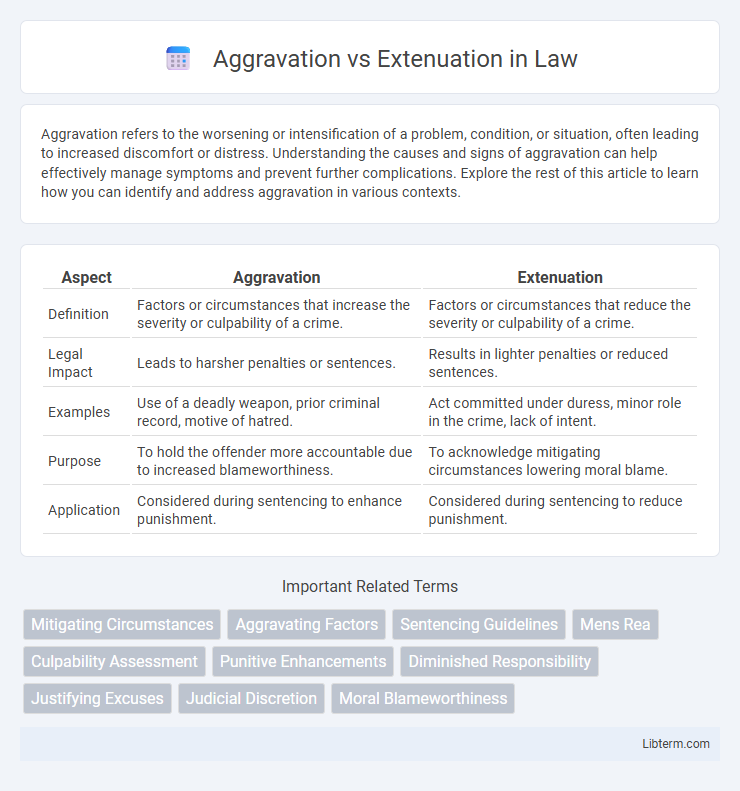Aggravation refers to the worsening or intensification of a problem, condition, or situation, often leading to increased discomfort or distress. Understanding the causes and signs of aggravation can help effectively manage symptoms and prevent further complications. Explore the rest of this article to learn how you can identify and address aggravation in various contexts.
Table of Comparison
| Aspect | Aggravation | Extenuation |
|---|---|---|
| Definition | Factors or circumstances that increase the severity or culpability of a crime. | Factors or circumstances that reduce the severity or culpability of a crime. |
| Legal Impact | Leads to harsher penalties or sentences. | Results in lighter penalties or reduced sentences. |
| Examples | Use of a deadly weapon, prior criminal record, motive of hatred. | Act committed under duress, minor role in the crime, lack of intent. |
| Purpose | To hold the offender more accountable due to increased blameworthiness. | To acknowledge mitigating circumstances lowering moral blame. |
| Application | Considered during sentencing to enhance punishment. | Considered during sentencing to reduce punishment. |
Understanding Aggravation and Extenuation
Understanding aggravation involves recognizing factors or actions that increase the severity or culpability of a crime, leading to harsher penalties. Extenuation refers to circumstances that lessen the blame or guilt, often resulting in reduced sentences or mitigated charges. Both concepts play critical roles in criminal law by influencing judicial decisions based on the context of the offense.
Legal Definitions and Key Differences
Aggravation in legal terms refers to factors or circumstances that increase the severity or culpability of a criminal act, often leading to harsher penalties, such as the use of a deadly weapon or prior convictions. Extenuation denotes circumstances that lessen the moral blame or severity of the offense, such as acting under duress or diminished capacity, potentially resulting in reduced charges or lighter sentencing. The key difference lies in aggravation enhancing punishment due to the negative factors, whereas extenuation mitigates punishment by highlighting redeeming or mitigating circumstances.
Common Examples of Aggravating Factors
Common examples of aggravating factors include prior criminal history, use of a weapon, causing severe injury or death, committing the offense in a vulnerable victim's presence, and acting with premeditation or extreme cruelty. These elements increase the severity of a crime, often resulting in harsher penalties or longer sentences. Courts consider aggravating factors to ensure justice reflects the seriousness of the offender's conduct.
Typical Extenuating Circumstances in Law
Typical extenuating circumstances in law include factors such as the defendant's lack of prior criminal history, mental illness or cognitive impairment, duress, and intoxication at the time of the offense. These conditions may reduce the severity of the punishment by demonstrating diminished culpability or impaired judgment. Courts weigh such factors to ensure a more equitable sentencing process based on the individual circumstances surrounding the crime.
The Role of Intent in Sentencing
Aggravation in sentencing occurs when the defendant's intent demonstrates malice, premeditation, or reckless disregard, leading to harsher penalties. Extenuation involves circumstances where the intent is diminished by factors such as provocation, lack of prior criminal history, or mental impairment, resulting in reduced sentences. Courts analyze the defendant's state of mind to determine whether the intent elevates culpability or justifies leniency under criminal law.
Impact on Criminal Penalties
Aggravation factors increase the severity of criminal penalties by highlighting elements such as premeditation, use of a deadly weapon, or prior convictions, leading to harsher sentences including longer imprisonment or higher fines. Extenuation factors, such as lack of intent, provocation, or remorse, can reduce penalties by mitigating the perceived culpability, often resulting in lighter sentences or alternative punishments like probation. Courts weigh these factors to balance justice and fairness, impacting sentencing severity and defendant outcomes in criminal law.
Judicial Discretion and Balancing Factors
Judicial discretion in cases involving aggravation versus extenuation requires careful balancing of factors such as the severity of the offense, the defendant's intent, and mitigating circumstances like mental health or provocation. Courts weigh aggravating elements like prior criminal history, cruelty, or premeditation against extenuating factors including remorse, youth, or lack of prior offenses to determine just sentencing. This nuanced evaluation ensures the punishment aligns proportionally with the individual case's complexities and promotes equitable justice outcomes.
Case Studies Highlighting Contrasts
Case studies reveal how aggravation factors, such as prior convictions or use of weapons, lead to harsher sentencing by demonstrating increased culpability or threat level. In contrast, extenuation factors like mental illness or lack of intent often result in reduced penalties, emphasizing the defendant's diminished moral blameworthiness. Comparative analysis of landmark cases showcases how courts balance aggravation and extenuation to deliver context-sensitive judgments.
Importance in Plea Bargaining
Aggravation factors, such as prior convictions or use of violence, significantly increase the severity of charges and influence harsher sentencing outcomes in plea bargaining. Extenuation factors, including genuine remorse or minor role in the crime, can mitigate punishment by persuading prosecutors to offer reduced charges or lighter sentences. Understanding the balance between aggravation and extenuation is crucial for negotiating effective plea deals that reflect the defendant's circumstances and legal strategy.
Aggravation and Extenuation in Public Perception
Aggravation in public perception often intensifies negative judgments by highlighting the severity or malicious intent behind an action, thereby increasing social condemnation and legal penalties. Extenuation, conversely, seeks to mitigate blame by emphasizing mitigating circumstances such as stress, lack of intent, or external pressures, which can evoke empathy and reduce perceived culpability. Understanding these concepts' influence on public opinion is crucial for legal professionals and communicators in shaping narratives around accountability and justice.
Aggravation Infographic

 libterm.com
libterm.com